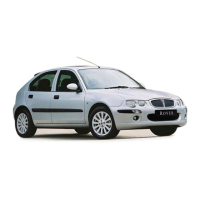Catalytic Converter
65
2
Catalytic Converter
CATALYTIC CONVERTER
Exhaust temperatures can be extremely high; do not park on
ground where combustible materials such as dry grass or leaves
could come into contact with the exhaust - a fire could result!
The exhaust system on your car incorporates a catalytic converter
(two on some models), which converts poisonous exhaust
emissions from the engine into environmentally less harmful gases.
Catalytic converters are easily damaged through improper use,
particularly if the wrong fuel is used; observing the following
precautions will minimise the risk of accidental damage.
Fuel
• Use ONLY fuel recommended for your car.
• Never allow the car to run out of fuel - this could cause a
misfire which could damage the catalyst.
Starting
• Do not continue to operate the starter after a few failed
attempts, seek qualified assistance.
• Do not operate the starter if an engine misfire is suspected, nor
attempt to clear a misfire by pressing the accelerator pedal.
• Do not attempt to push or tow start the car.
Driving
Any engine misfire, loss of engine performance or engine run-on,
could seriously damage the catalytic converter. For this reason, it
is vital that unqualified persons do not tamper with the engine, and
that regular maintenance is carried out in accordance with the
service interval plan in the ‘Service History’ section.
• Do not overload or excessively ‘rev’ the engine, or turn off the
engine when the car is moving with a drive gear selected.
• Consult your dealer if you think your car is burning too much
oil, as this will progressively reduce catalyst efficiency.
• If a misfire is suspected, or the car lacks power, you may drive
SLOWLY (at risk of catalyst damage) to a dealer, provided the
engine has reached its normal operating temperature.
• Do not run the engine with a spark plug or lead removed or use
any device that requires an insert into a spark plug hole.
• Do not drive on terrain likely to subject the underside of the
car to heavy impacts.
HB0086a

